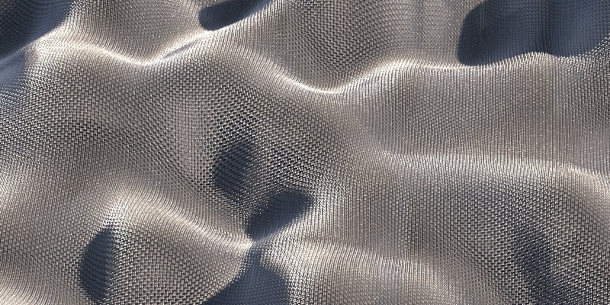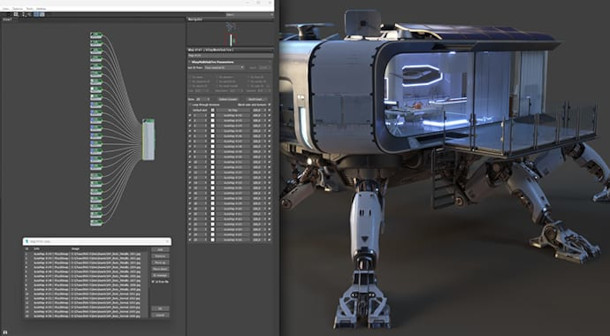Chaos releases V-Ray 6 for 3ds Max
Originally posted on 8 June 2022, and now updated with news of the commercial release.
Chaos has released V-Ray 6 for 3ds Max, the next major version of the production renderer – and the first of the next generation of updates to the entire V-Ray product family – as a free public beta.
New features include Chaos Scatter, a fully featured standalone object scattering tool, and VRayEnmesh, an interesting new system for repeating geometry across the surface of an object without instancing.
The update also adds support for procedural clouds in VRaySky, a new Finite Dome mode for the Dome Light, an integrated Thin Film layer in VRayMtl, and updates the VFB and V-Ray GPU render engine.
The first of a new generation of updates to the V-Ray product family
Chaos typically introduces new features in the 3ds Max and standalone editions of V-Ray before rolling them out the other versions, starting with V-Ray for Maya.
As a result, the V-Ray 6 beta provides a glimpse not just of the new features for 3ds Max users, but of the next generation of releases for the product family as a whole.
New standalone Chaos Scatter tool provides an alternative to third-party plugins
Major new features in V-Ray 6 for 3ds Max include Chaos Scatter, Chaos’s new standalone object scattering tool, first rolled out with Corona 8 earlier this year.
It provides an alternative to traditionally fuller-featured third-party scattering plugins like iToo Software’s Forest Pack: you can see a partial feature comparison in this forum thread.

New Enmesh modifier generates repeating surface geometry without instancing
Another interesting new feature is the VRayEnmesh modifier, which covers the surface of an object with repeating geometry, in a way analogous to tiling a texture.
Unlike instancing, no extra memory is used by the repeating geometry – only the source mesh is loaded – making it possible to have “billions of polygons [in a scene] without any impact on the memory consumption”.
Suggested use cases range in scale from fences to chainmail and rattan to the micro-structure of fabrics.
The system is a work in progress, and does not currently support V-Ray GPU, the software’s GPU-enabled render engine. Other current limitations are listed in this forum thread.
Materials and textures: updates to VRayMtl and VRayDecal
VRayMtl, the standard V-Ray Material, gets some significant updates in V-Ray 6.
Changes include an integrated Thin Film layer, for creating iridescent materials like soap bubbles and oil spills: effects previously only achievable via an OSL shader.
There is also a new implementation for SSS mode, which should speed up rendering of translucent materials.
In addition, energy compensation has been implemented in the GTR BRDF, which should fix a long-standing issue in which reflections appear unrealistically dark at very low glossiness values.
VRayDecal, the texture projection system introduced in V-Ray 5 for 3ds Max Update 2, now supports displacement maps.

Lighting: new procedural cloud system in VRaySky, updates to the Dome Light
VRaySky, V-Ray’s physically accurate sky system, get support for procedural clouds: a feature based on technology from real-time rendering firm Enscape, with which Chaos merged this year.
The implementation is currently limited to a single cloud layer, and it isn’t possible to render from above or inside it, but judging by test renders in this forum thread, it holds up pretty well in close-ups.
The clouds also cast shadows on environment fog.
Other lighting changes include the new Finite Dome mode for the V-Ray Dome Light, for fine tuning light projection onto ground surfaces via three new settings: Radius, Projection height and Ground blend settings.
Rendering: updates to V-Ray GPU, Cryptomatte and the VFB
V-Ray GPU, V-Ray’s GPU-enabled render engine, continues to move closer to feature parity with the main CPU render engine, with V-Ray 6 adding support for the VRaySphere geometry type.
You can see a current feature comparison for the two render engines here.
Other V-Ray GPU features planned for V-Ray 6 include a new device manager, making it possible to run the base render and the AI denoiser on separate GPUs.
VRayCryptomatte, the Cryptomatte ID matte render element available in both V-Ray GPU and the CPU render engine, gets support for deep output.
The V-Ray Frame Buffer (VFB) also gets a number of new features, including a panorama viewer, a new Proportion Guides Layer to help with scene composition, and a Flip button to flip the image.
Users can also send renders to Chaos Cloud directly from the VFB to solicit feedback from clients or collaborators, with viewers able to add annotations and comments.
More features to come in future beta builds
Workflow improvements include a new hierarchy view in VRayProxy, making it easier to toggle the visibility of individual objects or material overrides.
You can see a complete list of new features via the links at the foot of this story: Chaos says that the final release is still months away, and that more new features will be added before them.

Updated 7 July 2022: The final release came rather sooner: Chaos has just shipped V-Ray 6 for 3ds Max.
New features not covered in our original story include batch loading of textures to VRayMultiSubTex, and support for sequences of .vrscene files, with V-Ray loading each new file automatically on frame changes.
Now subscription-only, but licences work across eight other host applications
In addition, Chaos has changed its licensing model for V-Ray, making the software subscription-only, but with subscription licences now working across a range of host applications, not one.
There are three new subscription packages: V-Ray Solo, V-Ray Premium and V-Ray Enterprise.
V-Ray Solo subscriptions, which cost $466.80/year, are node-locked; floating V-Ray Premium subscriptions cost $694.80/year. V-Ray Enterprise subscriptions are bulk discounts for buying five or more seats.
Each works with “all supported host applications [including] 3ds Max, Cinema 4D, Houdini, Maya, Nuke, Revit, Rhino, SketchUp and Unreal”: the full current set of commercial V-Ray integations, bar form.Z.
All subscriptions also include access to the Chaos Cosmos asset library.
Premium and Enterprise subscriptions also include access to material library Chaos Scans and three other applications: scene-exploration tool Chaos Vantage, newly rebranded image player Chaos Player, and fluid simulation tool Chaos Phoenix, itself also now subscription-only.
Although Chaos has stopped sales of perpetual licences, previously priced at $1,180, users with existing perpetual licences of V-Ray 3+ for 3ds Max can upgrade to V-Ray 6 for 3ds Max only.
Pricing, system requirements and release date
V-Ray 6 for 3ds Max is compatible with 3ds Max 2018+, running on Windows 8.1+.
Some of the new features in the release require 3ds Max 2019 or later, including the V-Ray Proxy hierarchy, batch loading of multi-sub textures, and Chaos Cloud collaboration from the VFB.
The software is now rental-only, with new V-Ray Solo subscriptions costing $77.90/month or $466.80/year, V-Ray Premium costing $144.90/month or $694.80/year, and V-Ray Enterprise costing $598.80/year.
Read an overview of the new features in V-Ray 6 for 3ds Max on Chaos Group’s website
Read a full list of new features in V-Ray 6 for 3ds Max in the online release notes
